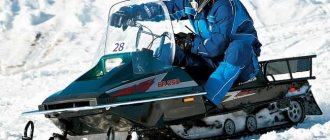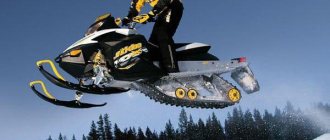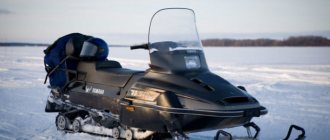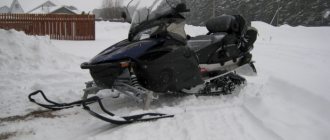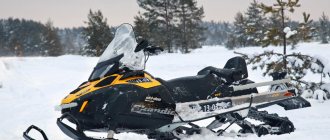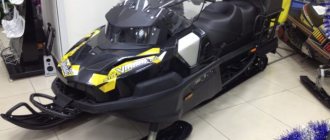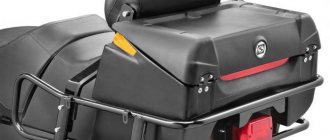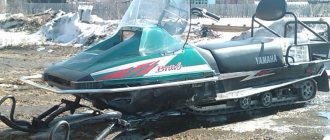Yamaha VK Professional II is a universal snowmobile from a Japanese company, in demand on the world market. The machine combines advanced technologies and an innovative level of equipment. The device is equipped with a proprietary engine of the Genesis EFI family, with an improved radiator and an electronic injection system. The power plant operates in conjunction with an updated V-belt variator. All these details, as well as many other parameters of the Yamaha Professional 2 snowmobile, are presented in this article.
Yamaha engineers managed to create a machine that meets international standards and regulations, and at the same time, satisfies all the needs of demanding owners. The snowmobile of the same name was successfully tested in the northern regions of Russia and received positive feedback from users. The manufacturer used the latest technologies in the car, the potential of which is designed for several years to come. The model in question quickly became popular on the Russian market, namely in the northern regions of our country. It is noteworthy that this device was produced for about ten years, and during this time this snowmobile underwent almost no changes, and at the same time remained popular. The secret of the success and durability of the Yamaha Professional 1 snowmobile is in its high-tech design, which at the time of launch into the series was technically advanced and had practically no analogues. Of course, over time, the Japanese had to refine the design in order to maintain stable demand at a high level. But in the end, when the car became completely outdated, Yamaha released the second generation - Yamaha Professional 2, which is a completely new machine. This device is respected by real professionals, fishermen and hunters, as well as athletes. Before us is a reliable and unpretentious car, which is famous for being created for life and work, for relaxation and family adventures. In other words, this is a universal model with extensive functionality. The designers managed to create a balanced design in terms of handling, load capacity and driving performance.
As for the design, the Yamaha Professional 2 snowmobile is designed in a classic and unattractive style, with the black version considered especially popular. For some users, such a modest design may seem boring. Yamaha took a different path and decided to abandon regularly updating the appearance of the car, introducing a wide range of colors, carbon levers, “alloy wheels” and other delights. The Japanese developer remained faithful to the classic design concept, so the snowmobile in question is very similar to its predecessors.
Video
Yamaha's marketing department is focusing on utility snowmobiles, unlike its closest competitors BRP and Polaris, which are more focused on producing recreational machines. However, competition in the global snowmobile market remains fierce. In this regard, Yamaha decided to occupy all price niches and release a family of snowmobiles aimed at users with different needs. This may explain the higher status of the Professional 2 model compared to its predecessor. The new product is positioned as a premium snowmobile, which differs significantly from the basic version of the VK 540IV. The Japanese consider this device to be one of the flagship machines designed to compete with the best snowmobiles of Canadian and Finnish production.
Of course, during the development of the second generation, Yamaha took into account all the advantages and got rid of most of the disadvantages inherent in the first generation. But at the same time, the design features have remained virtually unchanged, since there is no point in refining something that is relevant even today (ten years later). The Japanese created such a successful design that it did not have to be modified in the second generation. And yet, there were some additional functions and innovations.
As befits such top-level models, the Yamaha Professional 2 is equipped with lightweight composite materials that reduce the overall weight of the snowmobile and make it more maneuverable and economical. The shape of the snowmobile hood cover is made in a simple style - in it you should pay attention not to beauty, but to rational and aerodynamic shapes. The ergonomics of the bonnet provide an ideal location for the light, with the headlight itself located at the highest point to provide the best illumination in case of bad weather. The hood is made of durable plastic that is impact resistant. Using the hood cover as an example, you can see that all other body panels of the snowmobile were created taking into account aerodynamic parameters - for this, in fact, the car was “blown through” in a wind tunnel. Such tests made it possible to prevent possible turbulence in the driver’s legs and shoulders. I must admit that it is one of the few snowmobiles that has been tested in such harsh conditions. After fine-tuning the aerodynamics, the designers just had to complete the final touches - choosing the body color and bringing the design to the corporate concept.
The ergonomics of the driver's seat are performed at a high level. So, the seat was raised in relation to the footrests. The result is a fairly high seat, which is a bit unusual for most budget snowmobiles. But practice shows that this particular seat arrangement is the most convenient for most professionals who prefer to ride not only while sitting, but also while standing.
The Yamaha Professional 2 snowmobile received a more “toothy” Camoplast Cobra WT track. Its length is 154 inches, which is equivalent to 3923 mm. The width reaches 55 mm. The lug height is 38 mm. The caterpillar has small “scales” that improve traction properties, which is very important when driving on slippery and icy roads. By the standards of utilitarian snowmobiles, the Professional 2 model has cross-country ability comparable to the best snowmobiles in this price category. At the same time, thanks to such tracks, it was possible to achieve excellent maneuverability and responsiveness of the front swivel skis when turning the steering column sharply. The Professional 2 takes turns effortlessly, without any skidding or slipping. Despite the presence of only one ski, the snowmobile has optimal directional stability, by utilitarian standards. Wide tracks located on the sides contribute to stability. And stability, in turn, helps prevent the machine from tipping over or turning over. From this point of view, security has been improved.
As a result, Japanese engineers have created a well-thought-out and balanced device in terms of controllability, spaciousness and efficiency. It is quite easy to maintain compared to other famous analogues. In addition, the Yamaha brand has great authority in the Russian market, and therefore it is not surprising that the Yamaha dealer network in Russia is developing at a rapid pace, and today it is in many parts of our country.
Snowmobile yamaha rs viking professional vk10d
RS Viking Professional is the most “charged” snowmobile from Yamaha’s utilitarian line. Its power plant is a three-cylinder, four-stroke “troika” with a displacement of 973 cubic centimeters. It is unlikely that an engine with a maximum power of 115 horsepower and excellent traction from idle, combined with ideally selected CVT settings, may not be enough in any situation. Even when hauling a heavy load on a sled or towing a broken-down snowmobile from a competing manufacturer, you will be pleased with the response of the “professional” engine to the throttle trigger. The large engine allows you to drive according to the “if in doubt, accelerate” principle: in any “ambush” situation, it’s enough to estimate the trajectory in advance and pull the trigger properly. However, do not forget to slightly close the throttle when maneuvering: this will return the skis to the ground, trying to get off the ground, and load them to choose the right curve in the turn.
Matching the powerful engine, which will easily allow you to reach an impressive maximum speed, is the braking system with a powerful four-piston caliper and ventilated disc.
A half-meter-wide track, wide and widely spaced skis, a very light steering wheel and a fairly high center of gravity, allowing you to confidently push the snowmobile into turns even in deep powder - this is the formula for excellent cross-country ability of the Viking Professional. However, do not forget to count your strength and snowmobile driving skills: if you properly plant a car weighing four hundred kilograms, then you are unlikely to be able to rescue it from snow captivity on your own.
Yamaha RS Viking Professional will make the train comfortable for you and your passenger. This will be facilitated by:
- separate nine-position adjustment of heated handles and trigger, as well as passenger handles;
- carefully thought out ergonomics of the hood, providing convenient access to the engine and battery;
- a high and wide effective windshield that directs air flow above the helmet and does not interfere with the view over it;
- spacious heated seat tank;
- good light from dual headlights;
- a comfortable saddle, although not a sofa, which at the same time allows you to control the snowmobile not only while sitting, but also while standing;
- wide frost-free footrests;
- mountain strap on the handlebars as standard.
Writing about Japanese quality has long become banal: Yamaha has long become the standard of reliability among snowmobiles. RS Viking Professional is no exception: large, powerful, reliable, unpretentious and excellent starting in any frost. Try it and you won't regret it, it's worth it!
Source
- https://panavto-yamaha.ru/pubs/12/
Specifications
- Engine – petrol, 4-stroke, displacement 1 liter
- Cylinders, pcs. – 3
- Cooling – liquid
- Cylinder diameter – 82 mm
- Piston stroke – 66 mm
- Fuel system – Mikuni injection, with liquid heating
- Intake/ignition/exhaust system – 2 valves per cylinder/Digital TCI/2 valves per cylinder
- Transmission – YVXC CVT with low and low gears, neutral and reverse
- Brakes – hydraulically driven, 4-piston calipers, ventilated discs
- Parking brake - mechanical
- Front suspension – independent, with two wishbones
- Front shock absorbers – Hydraulic Gas Cell
- Front suspension travel – 160 mm
- Rear suspension – ProComfort
- Rear shock absorbers – KYB 40 mm Piston, HPG
- Rear suspension travel – 287 mm
- Snowmobile dimensions, mm: Height – 1460, Length – 3270, Width – 1165
- Caterpillar dimensions, mm: Width – 500, Length – 3923, Height – 38
- Track – Camoplast Cobra WT
- Track between skis – 990 mm
- Fuel tank volume – 45 liters
Standard features: electric start, reverse, heated steering wheel and grips, halogen headlights, DC power outlet.
Engine
The car received a modern power plant, which replaced the internal combustion engine with a carburetor fuel system. We are talking about a Genesis family engine, which retains the in-line three-cylinder layout of the outdated carburetor engine from the RS Viking model. However, these are the only similarities, because otherwise both engines are very different. In terms of design, the Genesis engine is a completely new engine, which received electronic fuel injection (instead of a carburetor), as well as increased power - it has increased by 7 horsepower. As a result, the total output of the new internal combustion engine reaches 115 hp. With. The torque was also increased, and thereby achieved ideal traction characteristics for the premium class. At the same time, the developers did not forget about the reliability of the most important components and components of the motor. Thus, due to the increased power and greater load, the belt had to be modified during snatch testing. The new injection system has significantly reduced fuel consumption, and the fuel tank now holds 44 liters of fuel. According to official data, support for AI-92 and AI-95 gasoline has been announced.
Taking into account the increased capacity of the fuel tank, we can talk about excellent efficiency and a large range of the Yamaha VK Professional 2 snowmobile. Below we present the results of tests that took place in Surgut. In conditions of deep snowdrifts, the car demonstrated unprecedented results in cross-country ability, as well as efficiency and power reserve, despite the enormous load on the engine, which was constantly operating at maximum speed. Thus, tests in such conditions confirmed that the Genesis family engine is adapted specifically for such regions, with a lot of snow. Moreover, it is in such conditions that the full potential of this power plant can be revealed.
Reviews
- Alexander, Ryazan. A worthy model for all needs. A universal, quiet and economical device for every day. He looks modest, but behaves very cheerfully. The technology impressed me in all respects. Unfortunately, at the time of sale it cost me more than 1 million rubles. But I think that the Professional 2 snowmobile is worth the money, if only because it never breaks down. Now the mileage is 1000 kilometers, and nothing has broken yet. There is support for 92 gasoline. I will note the high cross-country ability and responsive handling, as well as vigorous acceleration up to maximum speed. The suspension is tuned in such a way that you can enjoy it on a compacted and level road, without driving into deep snowdrifts. In general, the chassis has large strokes, which should be sufficient for off-road use. But unfortunately, the snowmobile quickly digs in and sits on its belly. When trying to get out of a snow trap, even the reverse does not help - you have to push or call a tow. But it’s better to ride together - extra help won’t hurt, and you won’t have to call a tow. In general, the car is aimed mainly at fans of high-speed driving, and it is better to venture off-road only as a last resort.
- Anton, Novosibirsk. A good quality machine, nothing creaks or rattles in it, unlike my previous Buran snowmobile, which for some reason still works. It is certainly better than the Yamaha in terms of cross-country ability and load-carrying capacity, but is fundamentally inferior in handling. The Yamaha also performs well off-road, and is even capable of getting out of deep snow captivity if you press the gas hard. The powerful engine confidently pushes the car from a stop, even with slight slipping. Excellent traction comes in handy off-road, and this to some extent compensates for the shortcomings of the mediocre chassis, which, nevertheless, is more tuned to driving on flat and compacted roads. At the same time, the large strokes of the suspension arms can withstand jumps, riding on trampolines and other heavy loads well. And at the same time, the snowmobile remains safe and sound - this is what it means when the machine is made of high-quality and durable materials that do not need to be changed every week, unlike Buran, which was assembled in a clunker.
- Daniil, Kursk. Yamaha Professional 2 is by far the best snowmobile I've ever owned. The car impressed me immediately as soon as I got behind the wheel. Currently the mileage is 300 kilometers. I understand that this is not enough to make a full review. But the fact is that I discovered not only advantages. So, in terms of advantages, everything is clear - excellent handling, efficiency, powerful engine, comfortable seat and dashboard, high windshield, etc. Among the disadvantages, I will note mediocre cross-country ability. Or rather, the car overcomes deep snowdrifts quite well, but only for a while until the engine overheats. The fact is that in such conditions the engine operates at high speeds, the tracks constantly slip, and overheating occurs. Unfortunately, liquid cooling for some reason does not cope with its task, and I consider this the main disadvantage. I will also note the expensive maintenance and the fact that the engine is demanding on the quality of fuel; for greater reliability it is better to fill it with AI-95. The car does not have a record capacity, although two people can ride. The trunk can accommodate only the most necessary fishing and hunting accessories, as well as some spare parts and a canister of fuel.
Buy in the online store, best prices, inexpensive delivery
Yamaha snowmobiles are considered an indispensable means of transportation on the winter road and can be used as a form of transport for sports, hunting, fishing and walks in the snowy forest. Snowmobiles are selected taking into account several main factors. If the snowmobile is light, the engine power and carrying capacity of the snowmobile are usually lower, and light snowmobiles are not designed for towing and are not equipped with towbars. A snowmobile with wide and long tracks is less maneuverable, however, wide tracks make it possible to increase the stability of the snowmobile on roads with difficult terrain. Yamaha snowmobiles are equipped with 2-stroke and 4-stroke engines that drive the tracks, and if you need a snowmobile for recreation (without towing), then a 2-stroke engine is quite suitable. A snowmobile with a 4-stroke engine, in turn, is more economical, requires less maintenance, and in terms of environmental friendliness it is significantly superior to snowmobiles with a 2-stroke engine. Yamaha, which is constantly improving its snowmobiles, has achieved low exhaust toxicity and the absence of a characteristic odor from engine operation in 4-stroke snowmobiles. A snowmobile for outdoor trips must be adapted to travel at low speeds, since otherwise it will be impossible to drive through difficult terrain. In this regard, when going to the forest or fishing, it is better to choose utilitarian snowmobiles designed for long trips and to overcome difficult areas. Reliable and easy-to-drive utilitarian Yamaha Viking snowmobiles are very popular, and the Viking PRO snowmobile is ideal for long distances. In utilitarian snowmobiles, some components are simplified, since this snowmobile is only required to be safely transported to its destination, overcoming deep snow. YAMAHA touring and sport snowmobiles are capable of high speeds and better maneuverability. The narrow seat of these snowmobiles allows the driver to shift his body during turns and maintain balance. Thanks to the engine shifted back and the most optimal location of the center of gravity, the manufacturers managed to increase the stability of the snowmobile on difficult sections of the track. The YAMAHA Venture touring snowmobile with long and wide tracks does not fall through even in deep snow and ensures maximum reliability and safety of the snowmobile. Great attention is paid to the comfort of touring snowmobiles, so YAMAHA made sure that the snowmobile had a wide backrest and a soft, comfortable seat.
Snowmobile Yamaha RS Viking Professional (Snowmobile Yamaha Professional).
Why, when we want the work to be done in the best possible way, that is, efficiently, reliably and quickly, we turn to professionals. Yes, because (as the explanatory dictionary explains) a professional is the best specialist, an expert in his field, the one who has made this specific work his profession. The same goes for choosing a snowmobile. Wanting to get the most reliable, comfortable, powerful, we, as always, choose the Yamaha RS Viking Professional, i.e. Professional.
Equipped with a wide (508 mm) Camoplast Ripsaw track and a high-torque Genesis 120 engine with low fuel consumption and high environmental performance, the Yamaha VK Professional is able to effortlessly carry not only two riders with all their considerable luggage, placed on a voluminous rear luggage platform and in a spacious trunk - chest under a comfortable soft seat, but also, if necessary, help a friend by pulling (or towing) him out of snow captivity. Hard crust or deep loose snowdrifts, a snowstorm or a prickly frosty wind - nothing is scary for the driver of the Yamaha VK Professional snowmobile protected by a high windshield with its two forward gears (plus reverse) and highly functional suspensions (rear - ProAction Plus of the breaking type, front – with curved arms). And add to this the heated grips, wide comfortable footrests, and a convenient digital dashboard, well, a professional is a professional, and you can’t think of anything better!
In 2012-2013, the Yamaha VK Professional (VK10D) snowmobile is available only in black and green colors.
Reviews.
If you consider yourself a serious professional and you need a unit that can perform any work in a snowy region, then you should turn your attention to the Yamaha RS Viking Professional snowmobile model - Yamaha Professional, reviews of which are available on almost all specialized forums. This 2011 model has already won the hearts of many professionals and those who like to ride on a good winter day across the snowy plains.
Yes, it is impossible to say that the Yamaha Professional is the latest development. Designers are constantly modifying the snowmobile model created back in 2006, adding new functions, refining individual technological components, and experimenting with suspension design and engine power.
For example, this snowmobile was originally equipped with a two-stroke engine that produced a maximum power of 120 horsepower. Now the 2011 model already has a four-stroke engine, which, with the same developed engine power, allows for significant savings in fuel consumption.
One of the most reliable, economical and powerful engines is the engine installed on the Yamaha Viking Professional snowmobile. Reviews of the operation of this unit are confirmed by many years of uninterrupted operation. The four-stroke engine has an electronic digital ignition, which is capable of ensuring high-quality fuel combustion and quick engine starting. Fuel enters the cylinders through 3 forty-millimeter carburetors. In general, this engine has been demonstrating its capabilities for several years in a row and has been proven through repeated operational tests.
All power from the engine goes to a large Camoplast RipSaw track that measures 156 inches long and 20 inches wide. This track rotates around a suspension on specially designed guide rails; the rear section of the track is hinged. High ridges of the track (1.25 inches) provide reliable grip of the snowmobile with the snow cover.
In turn, the articulated joints and flexible suspension design allow the snowmobile to bend when moving backwards so as not to get stuck tightly in the snow. Deltabox - Front suspension allows the drivetrain to sit low just behind the centerline of the skis. The downside of this sled is the outdated power steering design, but this will be fixed in the near future.
